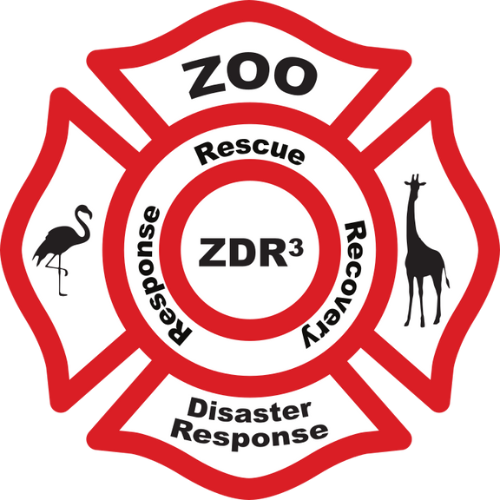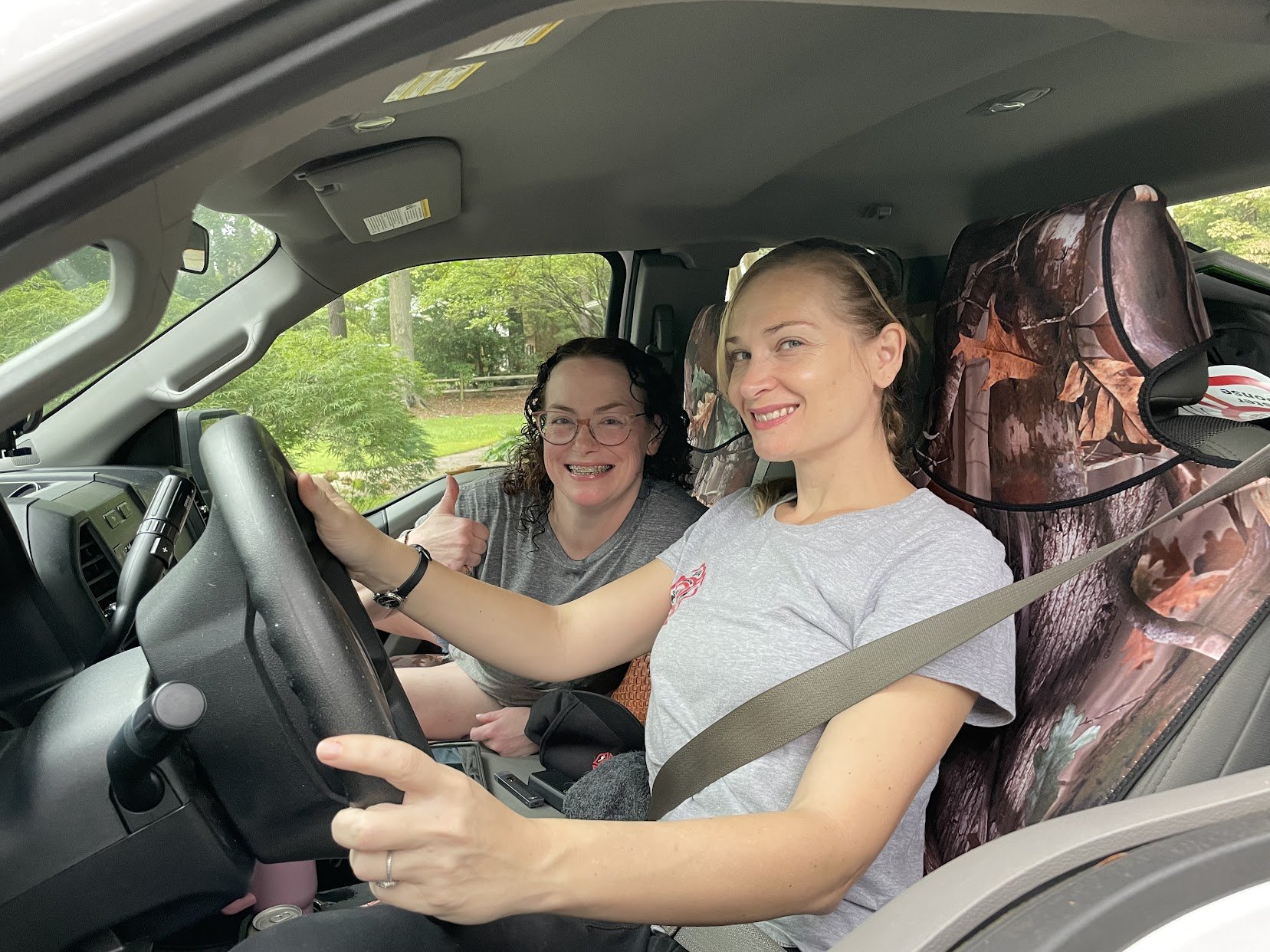ZDR3 Response Activities in 2024
ZDR3’s 2024 response season was intense, and the work we did was quite varied. In future posts we want to tell you some of the stories of individual response teams and impacted facilities, but first, here’s an overview of everything that happened!
This photo isn’t edited! Our California teams deployed into orange skies and firefighting helicopters flying constantly overhead.
Wildfires in California led to our first on-scene response in 2024. In early September, a native wildlife facility requested our assistance in evacuating their animals, including bears, deer, and eagles. ZDR3 Director Julia Wilder flew out to organize our on-scene response, assisted by our Communications Manager, Cari Wittenborn. Six network facilities and dozens of responders in the region came together to evacuate and house the animals until it was safe to return them to their home facility. While Julia and Cari were on scene in California, ZDR3 also provided remote support to another facility in the state that was beginning to consider evacuating their animals. We were proud of the incredible work completed by all the teams involved.
Once the on-scene portion of the California response wrapped up, Julia flew directly to the Association of Zoos and Aquariums’ annual conference in Calgary to represent ZDR3. While there she answered questions from attendees about ZDR3’s operation and met with responders from recently deployed response teams for debriefings.
As soon as our team returned home from the AZA conference, we immediately started to prepare for the third major hurricane of the year: Hurricane Helene. One of the benefits of having an established network like ZDR3’s is the ability for our team to identify which facilities might be impacted by an upcoming storm, which facilitates our ability to check in before impact to help determine and prepare for any future needs.
Helene intensified rapidly, which led us to pre-position staff near the area of expected impact in case travel to that area became lengthy or impossible. When Helene made landfall as a Category 4 hurricane, Julia and our Administrative Manager, Melanie Messer, were both hunkered down just north of the Florida/Georgia border, where they were managing requests for assistance. Anticipating they might lose power, they came equipped with back-up power and communications tech so they could keep fielding calls from impacted facilities and connecting them with response teams who were ready to roll.
Director Julia Wilder and Melanie Messer as they set off to pre-position for Hurricane Helene.
A highway sign warning about a tropical storm warning on a highway prior to Helene’s landfall.
Three facilities requested and received on-scene response from the ZDR3 network (from the same team!), and we provided remote response to three additional facilities. We were also in communication with 10 other facilities that, while not impacted heavily enough to need direct response, either requested some help with connectivity to government agencies and NGO support networks, or asked that we have teams on standby in case their level of need increased.
Zoo World’s response team with personnel from the second of three impacted facilities they helped after Helene. They had the most deployments of any team this response season - and all within two weeks!
Cari Wittenborn & Julia Wilder present on communicating during crisis at the ZAA Annual Conference.
A day after returning from Georgia, Julia, Cari, and Melanie headed to the Zoological Association of America’s annual conference in Columbus, Ohio. They continued managing response activities while en route and throughout the conference. Even though it was in the middle of a busy response season, we recognized how important it was for us to be present and in-person with response teams who attended the conference, as well as to meet with the leadership of facilities that might be impacted later in the season. Having a chance to connect directly with facility leadership who had crews currently conducting response or on standby helped expedite communications and decisions. That proved to be an important choice: the industry didn’t get a break for long.
A meeting with crew leads and responders during ZAA. Several in attendance were deployed within the next week.
When at a zoo conference, you can’t not take some time to enjoy Zoo Day! Cari and Julia got to meet an echidna.
In early October, less than two weeks after Helene made landfall, Hurricane Milton formed and became one of the most intense Atlantic hurricanes ever recorded. Fortunately, it weakened from a Category 5 to a Category 3 hurricane before it made landfall. But the heavy rain, strong wind, and tornadoes that accompanied Milton were an additional hardship on facilities that were in the process of resuming normal operations after Helene. We are thankful that Milton under-performed many of the meteorological forecasts and caused less damage to the central Florida region than had been predicted.
In the run-up to Milton, ZDR3 reached out to network members and other facilities that were in the potential impact zone, assisting facilities with their pre-planning and making sure we had a way to connect with them after the storm hit. Once Milton made landfall, Julia and the team traveled to Florida to assist with needs assessments for impacted facilities and coordinate response activities. ZDR3 ended up conducting three on-scene responses, provided remote response to another facility, helped two with connectivity to agencies and NGOs, and maintained communications with a combination of network and out-of-network facilities.
Teams from Fort Worth Zoo and Palm Beach Zoo work to clear fallen trees from Hurricane Milton.
A response team from Myakka Elephant Ranch was able to bring heavy equipment, which made a huge difference in clearing fallen trees and debris.
Responders from Keystone Safari, Big Cat Habitat, and Garden Brothers Circus stand with Director Julia Wilder in front of a pile of debris that was cleared from a wildlife rehabilitation facility after Milton. The equipment responders brought by the teams heavily expedited the work done on that site.
After our on-scene responders returned to their respective home facilities and our team was no longer in the field, we expected that ZDR3’s response season was wrapping up for the year. To our surprise, however, we were asked to undertake a slightly different type of support mission late in the season: a facility that was closing requested our assistance in helping place a portion of their animal collection. The ZDR3 Network assisted in helping find homes for these animals: 15 facilities were involved in facilitating the necessary communications, and eight responders from five teams came to the site to assist with capture and transport. All of the animals were successfully rehomed. After that work was finished, ZDR3’s personnel were able to deactivate for the season and return to steady state.
The work, however, doesn’t end when active response does. We spent the remainder of 2024 compiling metrics, creating after-action reports, and debriefing with our response teams and the facilities we helped. All of this afterwork performs a crucial role: it helps us identify areas of success and those in need of improvement. We’re using this information to help strengthen the support and guidance we provide our response teams in future seasons.
ZDR3 had more boots on the ground 2024 than in any other year, and we expect that growth to continue. We cannot express enough our gratitude and appreciation for all of the on-scene response teams that rolled to assist their colleagues this year, and for all the supporters who contributed remotely through social media shares and, of course, sent donations.
Thank you to our monetary donors for the 2024 Atlantic Storms Season!
Our tagline is “We are Stronger Together” for a reason - as a mutual aid group, ZDR3 cannot be successful without the backing of and contributions from our industry community. As the new year approaches, we look forward to what we can do together in 2025.












